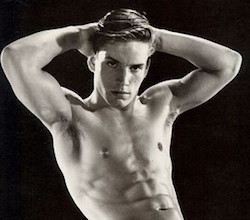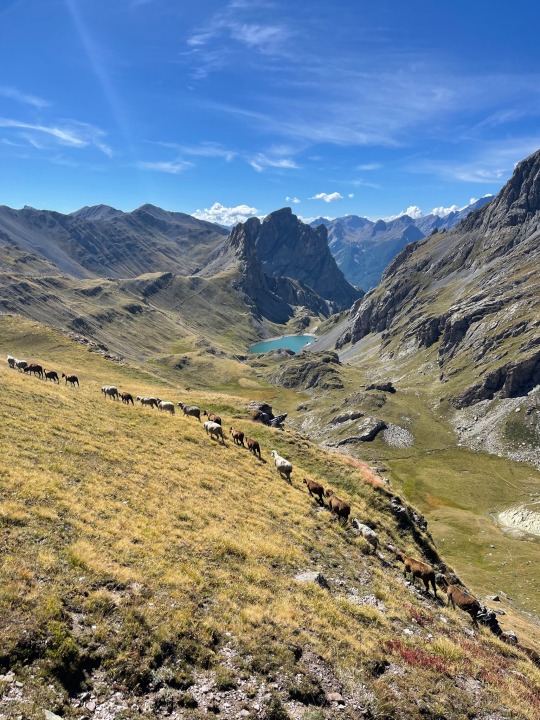#je t’aime geraldine
Text

Mαѕѕιƒ ∂єѕ Ɛ́cяιηѕ
Lαc ∂υ Lαυνιтєℓ / Ƒяαηcє 🇫🇷
Ɓу ©️LM®️
#massif des écrins#photographers on tumblr#nature#france#nature photographer#naturecore#montagne#mountains#la vie est belle#je t’aime geraldine#original photographers#original photography on tumblr#beautiful photos#original photography blog#photo on tumblr#french alps
183 notes
·
View notes
Photo

Geraldine Swayne — Je t’aime moi non plus (enamel on aluminium, 2014)
138 notes
·
View notes
Text
JOE DALLESANDRO: Body Worship

The faces and voices of movie stars past and present continue to be extensively written about and well covered, but what about the bodies on the screen? We saw most of Rudolph Valentino’s body, and enough of Clara Bow to want more. Jean Harlow iced her nipples to make them stand out and up at attention under her gowns, and Tyrone Power loved to wear the tightest possible pants to display his lower extremities. It was only in the 1950s, though, that Marilyn Monroe and Marlon Brando tested the limits of their clothes and wantonly imposed the fleshiest grabbable flesh. In the 1960s, the women in movies started getting rail-thin while one muscular and fleshy man took all of his clothes off on screen without any self-consciousness. In the area of exposing and idly flaunting on-screen flesh, this man is the all-time champion, and much more besides.
His name was and is Joe Dallesandro, a kid from the mean streets of New York who stole cars and went to reform school and acquired a scar on his knee after a gun battle with police. As a teenager, he began posing for nude photographs out in California, and he learned how to hit up gay guys for bread. “I’d come from New York where I’d seen people do the hustle,” Dallesandro said, “and I knew people could get away with anything if they just knew what to say. My hustle was about getting anything I could for nothing.” Back in New York at age eighteen in 1967, Dallesandro wandered into a Greenwich Village apartment where a movie was being shot, an underground movie made under the auspices of Andy Warhol and his Factory but controlled by Paul Morrissey, a mysterious, conservative figure who looked at Dallesandro and immediately liked what he saw.
Dallesandro went out to Arizona with the Warhol crew to make Lonesome Cowboys (1968), a queer anti-western where he does a hilariously open and polymorphously perverse little dance with sprightly Taylor Mead and is coached to do ballet pliés by another cowboy in order to build up his legs and butt (which certainly needed no building). At one point in San Diego Surf (1968), Warhol superstar Viva accidentally drops a baby and Dallesandro moves with a lightning fast reflex to catch it. At this point, it was clear that Dallesandro had a beautifully balanced and open face, with a sunburst smile that made him look innocent and childlike, and a body to make Michelangelo all hot and bothered. But he also had the pinched voice of a New York wise guy and skin that made it look like he probably ate mainly pizza. This contrast moved Morrissey, and maybe he was also moved by the knightly, responsible way that Dallesandro caught that baby before it fell to the ground.
In 1968, for very little money, Morrissey created a whole vehicle just for Dallesandro called Flesh, a film that nods to earlier Warhol experiments by opening with a two-and-a-half minute shot of Dallesandro’s sleeping face. After being rudely awakened by his demanding wife (Geraldine Smith), Dallesandro passively complains that she never does his laundry; he says a man’s job is protecting his family. He is wearing nothing but a cross around his neck.
Put-upon and beguilingly passive, standing in the street waiting for guys who might give him some money for nothing or for something a little more, Dallesandro in Flesh is as un-self-conscious as Louise Brooks in Pandora’s Box (1928), but his energy is more inward-directed. He doesn’t “act” so much as enter fully into any scenario Morrissey has given him like a little kid playing “let’s pretend” in their backyard. Every kid plays “let’s pretend,” but some kids are just more fun to play with than others, and the camera picks up on that, just as the person directing behind the camera can become entranced.
There are close-ups of Dallesandro in Flesh that stop the movie dead in its tracks. Like Marilyn Monroe and James Dean, Dallesandro knew exactly what to offer to a still camera, assuming all the attitudes from Back Off to Come Hither to Take Care Of Me. And always, essentially, he is distant and removed, which is his real trick, the thing that keeps people coming back for more. Often fully naked on screen, Dallesandro offers all of that bounty to the camera, but he keeps himself to himself.
In Lou Reed’s hit song “Walk on the Wild Side,” one section claims, “Little Joe never once gave it away/everybody had to pay and pay.” But Morrissey in Flesh is saying, even howling, yes, you can all have or stare at his body, but look at who he is! Look at all the beauty there in his face, in the way he moves, and particularly in his innate sense of masculine responsibility. He’s very funny in Flesh when he looks frankly bored and forlorn with some of his chattier clients, like a kid made to stay after school in detention who would much rather be outside, but his face is usually such a patient face, a stoic face, and always rivetingly photogenic. Maybe his screen presence is a bit of a hustle, too, but if it is, I’ll gladly pay and pay.
Morrissey’s conservatism might not come through as strongly as he thinks in his early films because he often ceded them to charismatic speakers for hedonism like Holly Woodlawn, who made a comic and tragic thing of her love for Dallesandro in Trash (1970). In that movie, Dallesandro plays an impotent drug addict who seems more dead than alive as women and men paw him and clutch at him. When Woodlawn is forced to use a beer bottle to get off sexually, Morrissey makes sure to cut to a close-up of Dallesandro holding her hand, one of the most moving images of tender disconnection in all of cinema.
Morrissey played Svengali with Dallesandro, who worked at Warhol’s Factory, trying to mold him into an ambiguous and unchanging star like John Wayne or Marlene Dietrich (at this time, Morrissey often spoke of wanting to remake The Blue Angel {1930} with Dallesandro playing Dietrich’s role of the inactive femme fatale Lola-Lola). In Morrissey’s Heat (1972), Dallesandro is cast as a washed-up child star angling for a comeback amid the hothouse improvisations of Sylvia Miles and Pat Ast. He has moved even further into a kind of waiting catatonia, but even at his most sedentary and unresponsive, Dallesandro signals that he is always on the make, occasionally throwing out a zinger when you least expect it just to prove that he can pay close attention to what’s going on around him when he wants to (but he usually doesn’t want to). Morrissey took his star to Europe to make back-to-back horror films, Flesh for Frankenstein and Blood for Dracula (both 1974), where Dallesandro has his funny, incongruous moments but mainly takes a backseat to the campy authority of Udo Kier.
Dallesandro decided to strike out on his own in the mid-1970s, and the results were rich and varied. “How’s it goin’?” he nonchalantly asks a moaning woman he is humping in Donna e Bello (1974), checking on her pleasure before sneaking a look at his wristwatch, like Jane Fonda does in Klute (1971). He made a lot of films in Italy where he was cast as psychos on crime sprees, yet those movies still captured moments of film-stopping purity in his face.
This quality he had was picked up on by Louis Malle, who made Dallesandro look princely and storybook-like in his experimental feature Black Moon (1975). Best of all in this period, Dallesandro appeared in Je t’aime moi non plus (1975), a vibrantly strange road picture directed by bad boy French songwriter Serge Gainsbourg. In that movie, Dallesandro plays Krassky, a gay truck driver who falls for Johnny (Jane Birkin), a roadside waitress. Maybe it’s because he’s dubbed in French, but in this movie something very romantic and almost Byronic emerges in Dallesandro, with elements of the goofiness that he had shown when he danced with Taylor Mead in Lonesome Cowboys.
While working in Europe, Dallesandro collaborated with a remarkable array of intriguing directors. In Walerian Borowczyk’s The Streetwalker (1976), Dallesandro himself pays for lady-of-the-night Sylvia Kristel. For the young Catherine Breillat, he was a sex object to a female director in Tapage nocturne (1979). During the making of Jacques Rivette’s Merry-Go-Round (1978, but only released in 1981), Dallesandro, his co-star Maria Schneider and Rivette himself were all in despair and trouble of some kind in their personal lives, so that the film has a very unsettling air of real desperation underneath Rivette’s suggestive, paranoid mise-en-scène. This is Dallesandro’s most touching work on screen. Even though he seems at the end of his tether in Merry-Go-Round, he still tries his very best to make sense of it all, like a kid trying to play a game when the rules of that game keep changing. Again, what comes across here is Dallesandro’s helpless sense of responsibility, the fact that he cares and wants to tidy up messes other people might make.
After beating a drinking problem, Dallesandro returned to the US and drove a limo for a while before being tapped by Francis Ford Coppola to play Lucky Luciano in The Cotton Club (1984), a film that he steals with his suave self-assurance in spite of limited screen time. In the movies he made after that, for Blake Edwards and John Waters and for many lesser talents, Dallesandro is never less than fully present and usually very inventively foul-mouthed. In Steven Soderbergh’s The Limey (1999), Dallesandro has a colorful small part as a slow henchman who manages to sink a shot on a pool table to his own much-evident and childlike delight. Let’s pretend!

In recent years, Dallesandro has managed a building in LA and he often single-handedly makes Facebook worthwhile with friendly quips, clips and all-around survivor humor. He’s cool with being a Sex God, skeptical of mythmaking, and quietly proud of his movies and his image. His Morrissey films secure him a place in film history, and his European work awaits further and more detailed investigation. He is an icon of a period and milieu when sex did not have boundaries, when pleasure was a vocation and a principle, and when a man taking off his clothes in front of a camera could not divert us from trying to find the part of himself that he would not give away.
by Dan Callahan
37 notes
·
View notes
Text

ᗰᗩSSIᖴ ᗪᕮ ᗷᕮᒪᒪᕮᗪOᑎᑎᕮ
ᖴᖇᕮᑎᑕᕼ ᗩᒪᑭS 🇫🇷
ᗷY ©️ᒪᗰ®️
#massif de belledonne#nature#france#j’aime les montagnes#naturecore#photographers on tumblr#nature photographer#mountains#montagne#la vie est belle#original photographe#original photography on tumblr#je t’aime geraldine#original photographers#original photography blog#photo on tumblr#love photography
158 notes
·
View notes
Text

ᒐᥱ ᙖᥱᥲᥙƒoɾtɩᥒ
ᔑᥲʋoɩᥱ / ᖴɾᥲᥒᥴᥱ 🇫🇷
ᙖყ ©️ᒐᙏ®️
#massif du beaufortin#beaufortain savoie#savoie#savoie mont blanc#nature#photographers on tumblr#nature photographer#naturecore#france#montagne#mountains#original phography#original photography blog#love photography#nature lovers#je t’aime geraldine#la vie est belle#photo on tumblr#nature photography#original photography on tumblr#original photographers
165 notes
·
View notes
Text

𝒫𝓁𝒶𝓉𝑒𝒶𝓊 𝒹𝓊 𝒞𝑜𝓇𝓃𝒶𝒻𝒾𝑜𝓃
𝒱𝑒𝓇𝒸𝑜𝓇𝓈 / 𝐹𝓇𝒶𝓃𝒸𝑒 🇫🇷
𝐵𝓎 ©️𝐿𝑀®️
#vercors#nature#naturecore#france#nature photographer#la vie est belle#montagne#mountains#amour#photographers on tumblr#je t’aime geraldine#nature lovers#original phography#original photography on tumblr#photo on tumblr#love photography#auvergne rhône alpes#alpes
189 notes
·
View notes
Text
(ᒐᥱ ᘎᥱɾᥴoɾ⳽)
Ꙇ⳽ᥱ̀ɾᥱ / ᖴɾᥲᥒᥴᥱ 🇫🇷
ᙖყ ©️ᒐᙏ®️
#massif du vercors#cascade de la gerlette#nature#france#vidéo cascade#photographers on tumblr#video nature#original video#je t’aime geraldine#la vie est belle#nature photographer#love nature#naturecore#my video#mountain is my life
129 notes
·
View notes
Text
ᴄαѕᴄαɗє ɗ,αຕᴏᴜя
ຕαѕѕɪғ ɗᴜ ᴠєяᴄᴏяѕ / ғяαηᴄє 🇫🇷
ʙу ©️Ɩຕ®️
#nature#vidéo cascade#cascade de france#cascade#cachoeira#photographers on tumblr#nature photographer#naturecore#france#je t’aime geraldine#jaime la nature#montagne#amour#vercors#mountains#massif du vercors#la vie est belle
141 notes
·
View notes
Text

Mᴀssɪғ ᴅᴇs Éᴄʀɪɴs
Lᴇ Gʀᴀɴᴅ ʟᴀᴄ
Fʀᴀɴᴄᴇ 🇫🇷
Bʏ ©️LM®️
#massif des écrins#nature#montagnes de france#jaime la nature#j’aime les montagnes#hautes alpes#photographers on tumblr#naturecore#france#nature photographer#mountains#montagne#original photography on tumblr#original phography#je t’aime geraldine#la vie est belle#original photography blog
69 notes
·
View notes
Text

Lᥲᥴ ᑯᥱ⳽ Cᥱɾᥴᥱ⳽ ( 2410m )
Mᥲ⳽⳽ɩƒ ᑯᥱ Cᥱɾᥴᥱ⳽
Hᥲᥙtᥱ⳽ AꙆρᥱ⳽ / Fɾᥲᥒᥴᥱ 🇫🇷
Bყ ©️LM®️
#lac des cerces#hautes alpes#photographers on tumblr#nature#france#nature photographer#original photographe#original photographers#naturecore#montagnes de france#lac de france#lac de montagne#je t’aime geraldine#montagne#mountains#original photography on tumblr#original phography#love photography#nature photography
70 notes
·
View notes
Text

Lმƈ ძմ Cɾօzεէ
Mმʂʂἶբ ძε Bεllεძօղղε / Fɾმղƈε 🇫🇷
Bყ ©️LM®️
#montagnes de france#lac du crozet#lacs de france 🇫🇷#nature#france#photographers on tumblr#nature photographer#naturecore#je t’aime geraldine#montagne#mountains#original phography#original photography on tumblr#original photography blog#photo on tumblr#love photography#nature photography#beautiful photos
79 notes
·
View notes
Text
𝐵𝑖𝑒𝑛𝑣𝑒𝑛𝑢𝑒 𝑠𝑢𝑟 𝑚𝑜𝑛 𝑡𝑒𝑟𝑟𝑎𝑖𝑛 𝑑𝑒 𝑗𝑒𝑢
(𝐿𝑒 𝑉𝑒𝑟𝑐𝑜𝑟𝑠)
𝐼𝑠𝑒̀𝑟𝑒 / 𝐹𝑟𝑎𝑛𝑐𝑒 🇫🇷
𝐵𝑦 ©️𝐿𝑀®️
#malleval en vercors#massif du vercors#vercors#nature#nature photographer#france#photographers on tumblr#la vie boheme#la vie est belle#naturecore#je t’aime geraldine#original video#my video#video nature
64 notes
·
View notes
Text





𝘊𝘰𝘭 𝘥𝘦 𝘭𝘢 𝘗𝘰𝘯𝘴𝘰𝘯𝘯𝘪𝘦̀𝘳𝘦 (𝟤𝟨𝟣𝟥𝘮)
𝘊𝘦𝘳𝘤𝘦𝘴-𝘛𝘩𝘢𝘣𝘰𝘳 / 𝘏𝘢𝘶𝘵𝘦𝘴-𝘈𝘭𝘱𝘦𝘴 / 𝘍𝘳𝘢𝘯𝘤𝘦 🇫🇷
𝘉𝘺 ©️𝘓𝘔®️
#cerces#thabor#photographers on tumblr#hautes alpes#serre chevalier#france#nature#nature photographer#la vie est belle#mountains#naturecore#montagne#amour#je t’aime geraldine#original photographe#original photography on tumblr#original phography#original photography blog#original photographers#original post#parc naturel
84 notes
·
View notes
Text
ᙅᥲ⳽ᥴᥲᑯᥱ ᑯᥙ ᖴᥙɾoᥒ
ᔑᥲ⳽⳽ᥱᥒᥲɠᥱ / Ꙇ⳽ᥱ̀ɾᥱ / ᖴɾᥲᥒᥴᥱ 🇫🇷
ᙖყ ©️ᒐᙏ®️
#nature#cascade du furon#france#sassenage#naturecore#photographers on tumblr#auvergne rhône alpes#nature photographer#original photographe#original video#je t’aime geraldine#la vie est belle#j’aime la nature#j’aime les cascades#florest nature
73 notes
·
View notes
Text

ᒐᥱ⳽ ᙓ́ᥴɾɩᥒ⳽
ᒐᥱ ρᥲɾᥲᑯɩ⳽ ᥲꙆρɩᥒ⳽
ᕈᥲɾᥴ ᥒᥲtɩoᥒᥲꙆ ᑯᥱ⳽ ᙓ́ᥴɾɩᥒ⳽ / ᖴɾᥲᥒᥴᥱ 🇫🇷
ᒐᥲᥴ ᑯᥙ ᒐᥲᥙʋɩtᥱꙆ
ᙖყ ©️ᒐᙏ®️
#massif des écrins#hautes alpes#lac du lauvitel#parc national des écrins#nature#france#naturecore#nature photographer#photographers on tumblr#original photography on tumblr#montagne#mountains#je t’aime geraldine#la vie est belle#amour#nature colors#parc naturel#love photography#original phography#original photography blog#original photographers#original photographe#nature photography#beautiful photos
68 notes
·
View notes
Text

𝙻𝚎 𝚁𝚊𝚝𝚎𝚊𝚞 𝚍’𝙰𝚞𝚜𝚜𝚘𝚒𝚜 (𝟹𝟷𝟸𝟾𝚖)
𝙼𝚊𝚜𝚜𝚒𝚏 𝚍𝚎 𝚕𝚊 𝚅𝚊𝚗𝚘𝚒𝚜𝚎 / 𝙵𝚛𝚊𝚗𝚌𝚎 🇫🇷
𝙱𝚢 ©️𝙻𝙼®️
#photographers on tumblr#massif de la vanoise#naturecore#france#nature#la vie est belle#nature photographer#original phography#original photography on tumblr#montagne#mountains#amour#original photographe#original photography blog#je t’aime geraldine#love photography#nature lovers#photo nature
107 notes
·
View notes